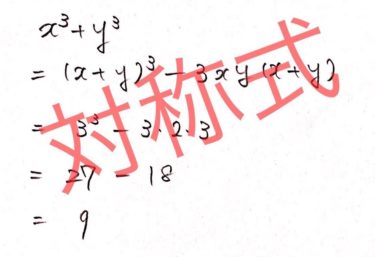「三角比の相互関係」を使った応用問題を解いておきたい!
テスト・入試によくでる応用問題はどんなものがあるの?
図を使ってわかりやすく解説してほしい!
こういった要望に応えます。
「三角比の相互関係」の公式は3つ。
- $\sin^2 \theta + \cos^2 \theta = 1$
- $\displaystyle { \tan \theta = {\sin \theta \over \cos \theta} }$
- $\displaystyle { 1 + \tan^2 \theta = {1 \over \cos^2 \theta} } $
これらの公式を使って解く問題は、学校のテスト でも 大学入試 でもよく出題されます。
このページを最後まで読むことで、テストや入試によく出るパターンの 三角比の応用問題 をひと通り学ぶことができます。
「自分は 三角比の頻出パターンをどれくらい理解できているのか?」をチェックする意味でもぜひ活用してください!
たくさん図を使いながら、視覚的にも分かりやすく丁寧に解説していきます!
- 1 【三角比の相互関係】テストによくでる応用問題 Lv.0 (三角比の値)
- 1.1 (1) $ \displaystyle { \cos \theta = { 1 \over \sqrt{3} } } $ $\displaystyle { \left( 0^\circ<\theta<90^\circ \right) }$
- 1.2 (2) $ \displaystyle { \sin \theta = { 2 \over 3 } } $ $\displaystyle { \left( 0^\circ<\theta<180^\circ \right) }$
- 1.3 (3) $ \displaystyle { \tan \theta = − { 1 \over \sqrt{5} } } $ $\displaystyle { \left( 0^\circ<\theta<360^\circ \right) }$
- 2 【三角比の相互関係】テストによくでる応用問題 Lv.1 (式を簡単に)
- 3 【三角比の相互関係】テストによくでる応用問題 Lv.2 (値を代入)
- 4 【三角比の相互関係】テストによくでる応用問題 Lv.3 (対称式)
- 5 【三角比の相互関係】テストによくでる応用問題 Lv.4 (三角方程式)
- 6 【三角比の相互関係】テストによくでる応用問題 Lv.5 (2次関数)
- 7 最後に
【三角比の相互関係】テストによくでる応用問題 Lv.0 (三角比の値)
まずは基本問題のおさらいです。
【問題0】三角比の1つが次の値をとるとき、他の2つの三角比の値を求めよ。
(1) $ \displaystyle { \cos \theta = { 1 \over \sqrt{3} } } $ $\displaystyle { \left( 0^\circ<\theta<90^\circ \right) }$
(2) $ \displaystyle { \sin \theta = { 2 \over 3 } } $ $\displaystyle { \left( 0^\circ<\theta<180^\circ \right) }$
(3) $ \displaystyle { \tan \theta = −{ 1 \over \sqrt{5} } } $ $\displaystyle { \left( 0^\circ<\theta<360^\circ \right) }$
$\theta$ の値のとる範囲 に気をつけながら解いていきましょう。
(1) $ \displaystyle { \cos \theta = { 1 \over \sqrt{3} } } $ $\displaystyle { \left( 0^\circ<\theta<90^\circ \right) }$
手順としては、
【公式①】$\cos \theta $ から $\sin \theta $ を求める
【公式②】$\cos \theta $、$\sin \theta $ から $\tan \theta $ を求める
というのが一番スムーズです。
- 【解答・解説】を見る
-
【解答】
$ $ $\sin^2 \theta + \cos^2 \theta = 1$
に $ \displaystyle { \cos \theta = { 1 \over \sqrt{3} } } $ を代入して
$ $ $ \displaystyle { \sin^2 \theta + \left( { 1 \over \sqrt{3} } \right)^2 = 1 } $
$ $ ∴ $\displaystyle { \sin^2 \theta + { 1 \over 3 } = 1 } $
$ $ ∴ $\displaystyle { \sin^2 \theta = { 2 \over 3 } } $
ここで、$\displaystyle { 0^\circ<\theta<90^\circ }$ より
$ $ $\sin\theta>0$ ・・・(注)
∴ $\displaystyle {\sin\theta = \sqrt{ 2 \over 3 } }$
$ $ $= \displaystyle { \sqrt{6} \over 3 } $
また、
$ $ $\displaystyle { \tan \theta = {\sin \theta \over \cos \theta} }$
$ $ $\displaystyle { = \sin \theta \cdot {1 \over \cos \theta} }$
$ $ $\displaystyle { = { \sqrt{6} \over 3 } \cdot \sqrt{3} }$
$ $ $\displaystyle { = { \require{cancel} \bcancel{3} \sqrt{2} \over \bcancel{3} } }$
$ $ $\displaystyle { = \sqrt{2} }$
(注)$0^\circ <\theta<90^\circ$ より、$\sin\theta$ の符号を 単位円で確認すると
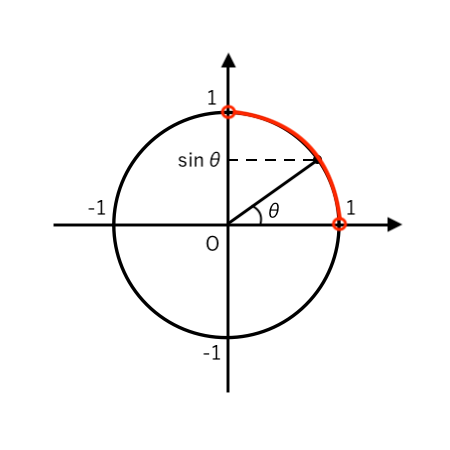
なので、$\sin\theta>0$(+)とわかります。
$\sin^2\theta$ の2乗を外すときに「正(+)の平方根」だけOKということですね。
(2) $ \displaystyle { \sin \theta = { 2 \over 3 } } $ $\displaystyle { \left( 0^\circ<\theta<180^\circ \right) }$
この問題も
【公式①】$\sin \theta $ から $\cos \theta $ を求める
【公式②】$\sin \theta $、$\cos \theta $ から $\tan \theta $ を求める
というのが良さげですね。
- 【解答・解説】を見る
-
【解答】
$ $ $\sin^2 \theta + \cos^2 \theta = 1$
に $ \displaystyle { \sin \theta = { 2 \over 3 } } $ を代入して
$ $ $ \displaystyle { \left( { 2 \over 3 } \right)^2 + \cos^2 \theta = 1 } $
$ $ ∴ $\displaystyle { { 4 \over 9 }+ \cos^2 \theta = 1 } $
$ $ ∴ $\displaystyle { \cos^2 \theta = { 5 \over 9 } } $
ここで、「$0^\circ <\theta<180^\circ$ かつ $\sin \theta>0$」すなわち
「$0^\circ <\theta<180^\circ$」より
$ $ $\displaystyle {\cos\theta = \pm \sqrt{ 5 \over 9 } }$
$ $ $= \displaystyle { \pm { \sqrt{5}\over 3} } $・・・(注1)
また、
$ $ $\displaystyle { \tan \theta = {\sin \theta \over \cos \theta} }$
$ $ $\displaystyle { = \sin \theta \cdot {1 \over \cos \theta} }$
$ $ $\displaystyle { = { 2 \over 3 } \cdot { \left( \pm { 3 \over \sqrt{5} } \right) } }$
$ $ $\displaystyle { = \pm { 2 \over \sqrt{5} } }$
$ $ $\displaystyle { = \pm { 2 \sqrt{5} \over 5 } }$・・・(注2)
以上より
$ $ $\displaystyle {\cos\theta = \pm { \sqrt{5}\over 3 } }$ , $\displaystyle { \tan \theta = \pm { 2 \sqrt{5} \over 5 } }$(複号同順)・・・(注3)
(注1)「$0^\circ <\theta<180^\circ$」より、単位円をかくと

$ \begin{cases}
\cos \theta >0(+)のとき \tan \theta >0(+) \\
\\
\cos \theta <0(−)のとき \tan \theta <0(−) \\
\end{cases}$なので、$\cos \theta$ 2乗を外すときに「正(+)の平方根」と「負(−)の平方根」の両方ともOKということです。
(注2)ここの計算は以下のように分けて書いてもOK。
・$\displaystyle {\cos\theta = { \sqrt{5}\over 3 } }$ のとき
$ $ $\displaystyle { \tan \theta = {\sin \theta \over \cos \theta} }$
$ $ $\displaystyle { = \sin \theta \cdot {1 \over \cos \theta} }$
$ $ $\displaystyle { = { 2 \over 3 } \cdot { 3 \over \sqrt{5} } }$
$ $ $\displaystyle { = { 2 \over \sqrt{5} } }$
$ $ $\displaystyle { = { 2 \sqrt{5} \over 5 } }$
・$\displaystyle {\cos\theta = − { \sqrt{5}\over 3 } }$ のとき
$ $ $\displaystyle { \tan \theta = {\sin \theta \over \cos \theta} }$
$ $ $\displaystyle { = \sin \theta \cdot {1 \over \cos \theta} }$
$ $ $\displaystyle { = { 2 \over 3 } \cdot { \left( − { 3 \over \sqrt{5} } \right) } }$
$ $ $\displaystyle { = − { 2 \over \sqrt{5} } }$
$ $ $\displaystyle { = − { 2 \sqrt{5} \over 5 } }$
以上より
$ $ $\displaystyle { (\cos\theta, \tan \theta) = \left( { \sqrt{5}\over 3 } , { 2 \sqrt{5} \over 5 } \right), \left( −{ \sqrt{5}\over 3 } , − { 2 \sqrt{5} \over 5 } \right) }$
(注3) 「複号同順」について
$ \begin{cases}
\displaystyle { \cos \theta = { \sqrt{5}\over 3 } } , \displaystyle { \tan \theta = { 2 \sqrt{5} \over 5 } } (+と+が対応)\\
\\
\displaystyle { \cos \theta = − { \sqrt{5}\over 3 } }, \displaystyle { \tan \theta = − { 2 \sqrt{5} \over 5 } } (−と−が対応)\\
\end{cases}$と同じ意味。
(3) $ \displaystyle { \tan \theta = − { 1 \over \sqrt{5} } } $ $\displaystyle { \left( 0^\circ<\theta<360^\circ \right) }$
今度は $ \tan \theta$ の値が与えられているので、
【公式③】$\tan \theta $ から $\cos \theta $ を求める
【公式②】$\tan \theta $、$\cos \theta $ から $\sin \theta $ を求める
という流れが一番ラクそうですね。
- 【解答・解説】を見る
-
【解答】
$ $ $\displaystyle { 1 + \tan^2 \theta = {1 \over \cos^2 \theta} } $
に $ \displaystyle { \tan \theta = − { 1 \over \sqrt{5} } } $ を代入して
$ $ $\displaystyle { 1 + \left( − { 1 \over \sqrt{5} } \right)^2 = {1 \over \cos^2 \theta} } $
$ $ ∴ $\displaystyle { {1 \over \cos^2 \theta} = { 6 \over 5 } } $
両辺の逆数をとって
$ $ $\displaystyle { \cos^2 \theta = { 5 \over 6 } } $
ここで、「$0^\circ <\theta<360^\circ$ かつ $\tan \theta <0$ 」すなわち
「$90^\circ <\theta<180^\circ$ , $270^\circ <\theta<360^\circ$」より
$ $ $\displaystyle { \cos\theta = \pm { \sqrt{ 5 \over 6 } } }$
$ $ $= \displaystyle { \pm { \sqrt{30} \over 6 } } $・・・(注1)
また、
$ $ $\displaystyle { \tan \theta = {\sin \theta \over \cos \theta} }$
の両辺に $ \cos \theta $ をかけて
$ $ $\displaystyle { \tan \theta \cdot \cos \theta = {\sin \theta \over \require{cancel} \bcancel{ \cos \theta } } \cdot \bcancel{ \cos \theta } }$
左辺と右辺を入れ替えて
$ $ $\displaystyle { \sin \theta = \tan \theta \cdot \cos \theta }$
$ $ $\displaystyle { = − { 1 \over \sqrt{5} } \cdot \left( \pm { \sqrt{30} \over 6 } \right) }$
$ $ $\displaystyle { = \mp { \sqrt{6} \over 6 } }$ ・・・(注2)
以上より
$ $ $\displaystyle {\cos\theta = \pm { \sqrt{30} \over 6 } }$ , $\displaystyle { \sin \theta = \mp { \sqrt{6} \over 6 } }$(複号同順)・・・(注3)
(注1)「$90^\circ <\theta<180^\circ$ , $270^\circ <\theta<360^\circ$」より、単位円をかくと

$ \begin{cases}
\cos \theta >0(+)のとき \sin \theta <0(−) \\
\\
\cos \theta <0(−)のとき \sin \theta >0(+) \\
\end{cases}$なので、$\cos \theta$ 2乗を外すときに「正(+)の平方根」と「負(−)の平方根」の両方ともOKということですね。
(注2)ここの計算は以下のように分けて書いてもOK。
・$\displaystyle {\cos\theta = { \sqrt{30} \over 6 } }$ のとき
$ $ $\displaystyle { \sin \theta = \tan \theta \cdot \cos \theta }$
$ $ $\displaystyle { = − { 1 \over \sqrt{5} } \cdot { \sqrt{30} \over 6 } }$
$ $ $\displaystyle { = − { \sqrt{6} \over 6 } }$
・$\displaystyle {\cos\theta = − { \sqrt{30} \over 6 } }$ のとき
$ $ $\displaystyle { \sin \theta = \tan \theta \cdot \cos \theta }$
$ $ $\displaystyle { = − { 1 \over \sqrt{5} } \cdot \left( − { \sqrt{30} \over 6 } \right) }$
$ $ $\displaystyle { = { \sqrt{6} \over 6 } }$
以上より
$ $ $\displaystyle { (\cos\theta, \sin \theta) = \left( { \sqrt{30} \over 6 } , − { \sqrt{6} \over 6 } \right), \left( −{ \sqrt{30} \over 6 } , { \sqrt{6} \over 6 } \right) }$
(注3) 「複号同順」について
$ \begin{cases}
\displaystyle { \cos \theta = { \sqrt{30} \over 6 } } , \displaystyle { \sin \theta = − { \sqrt{6} \over 6 } } (+と−が対応)\\
\\
\displaystyle { \cos \theta = − { \sqrt{30} \over 6 } }, \displaystyle { \sin \theta = { \sqrt{6} \over 6 } } (−と+が対応)\\
\end{cases}$と同じ意味。
【三角比の相互関係】テストによくでる応用問題 Lv.1 (式を簡単に)
「次の式を簡単にせよ。」というタイプの問題です。
「三角比の相互関係」の公式を使ってうまく変形していきます。
【問題1】次の式を簡単にせよ。
(1) $\displaystyle { { \cos\theta \over 1−\sin\theta } + { 1−\sin\theta \over \cos\theta } }$
(2) $ \sin (90^\circ − \theta) \cos (180^\circ − \theta) − \cos^2 \theta \tan^2 ( 180^\circ − \theta )$
(1) $\displaystyle { { \cos\theta \over 1−\sin\theta } + { 1−\sin\theta \over \cos\theta } }$
分数の形なのでとりあえず通分すると、三角比の相互関係が使えそうな形になってくれます。
- 【解答・解説】を見る
-
【解答】
$\displaystyle { { \cos\theta \over 1−\sin\theta } + { 1−\sin\theta \over \cos\theta } }$
$\displaystyle { = { \cos^2 \theta + ( 1−\sin\theta )^2 \over ( 1−\sin\theta )\cos\theta } }$
$\displaystyle { = { \color{red}{ \cos^2 \theta } + 1−2 \sin\theta + \color{red}{ \sin^2 \theta } \over ( 1−\sin\theta )\cos\theta } }$
$\displaystyle { = { \color{red}{ 1 } + 1−2 \sin\theta \over ( 1−\sin\theta )\cos\theta } }$ $ \left( \color{red} { \sin^2 \theta + \cos^2 \theta } = 1 を代入 \right) $
$\displaystyle { = { 2−2 \sin\theta \over ( 1−\sin\theta )\cos\theta } }$
$\displaystyle { = { 2 \require{cancel} \bcancel{ ( 1− \sin\theta ) } \over \bcancel{ ( 1−\sin\theta ) } \cos\theta } }$
$\displaystyle { = { 2 \over \cos\theta } }$
(2) $ \sin (90^\circ − \theta) \cos (180^\circ − \theta)− \cos^2 \theta \tan^2 ( 180^\circ − \theta )$
まずは
- 「$90^\circ − \theta$」→ 余角公式
- 「$180^\circ − \theta$」→ 補角公式
を使って変形します。
- 【解答・解説】を見る
-
【解答】
$ \begin{cases}
\color{red} {\sin (90^\circ − \theta)} = \cos \theta \\
\\
\color{green} {\cos (180^\circ − \theta)} = − \cos \theta \\
\\
\color{blue} {\tan ( 180^\circ − \theta )} = − \tan \theta \\
\end{cases}$より
$ \color{red} {\sin (90^\circ − \theta)} \color{green} {\cos (180^\circ − \theta)} − \cos^2 \theta \enspace \color{blue} {\tan}^2 \color{blue} {( 180^\circ − \theta )} $
$ = \color{red} {\cos \theta} \cdot ( \color{green} { −\cos \theta } ) − \cos^2 \theta \cdot ( \color{blue} {−\tan \theta} )^2 $
$ = − \cos^2 \theta − \cos^2 \theta \tan ^2 \theta $
$ = − \cos^2 \theta − \cos^2 \theta \left( \displaystyle {\sin \theta \over \cos \theta } \right)^2 $ $ \left( \displaystyle { \tan \theta = {\sin \theta \over \cos \theta} } を代入 \right) $
$ \displaystyle { = − \cos^2 \theta − \require{cancel} \bcancel{ \cos^2 \theta } \cdot { \sin^2 \theta \over \bcancel{ \cos^2 \theta } } } $
$ = − \cos^2 \theta − \sin^2 \theta $
$ = − ( \cos^2 \theta + \sin^2 \theta ) $
$ = −1 $ ($\sin^2 \theta + \cos^2 \theta = 1$ を代入)
(注)「余角公式」「補角公式」は暗記するのではなく、単位円をかいて考えましょう。
✔︎ $\sin (90^\circ − \theta) = \cos \theta$
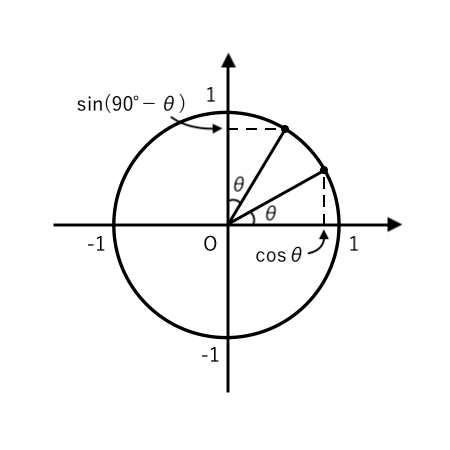
✔︎ $\cos (180^\circ − \theta) = − \cos \theta$
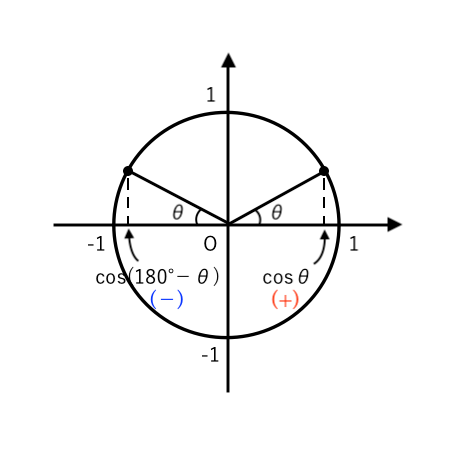
✔︎ $\tan ( 180^\circ − \theta ) = − \tan \theta$
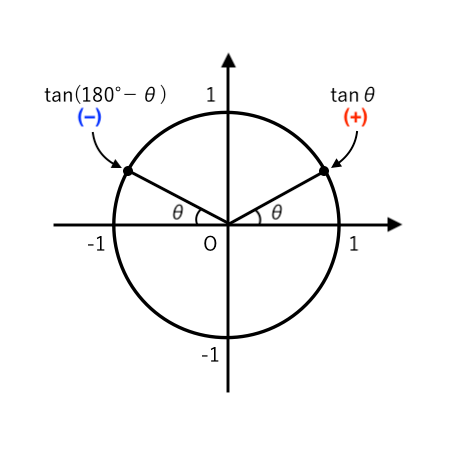
慣れてきたら頭の中でイメージするだけでもOK。
【三角比の相互関係】テストによくでる応用問題 Lv.2 (値を代入)
Lv.1の問題で学んだ考え方を活かして解いてみましょう!
【問題2】$ \displaystyle { \tan \theta = −{1 \over 2} } $ のとき、次の値を求めよ。
(1) $ \displaystyle { \sin \theta − \cos \theta \over \sin \theta + \cos \theta } $
(2) $ \displaystyle { {1 \over 1 + \cos \theta} + {1 \over 1 − \cos \theta} } $
[岡山理科大]
(1) $ \displaystyle { \sin \theta − \cos \theta \over \sin \theta + \cos \theta } $
「三角比の相互関係」の公式 $\displaystyle { {\sin \theta \over \cos \theta} = \tan \theta }$ をイメージすると方針が浮かんできます。
- 【解答】を見る
-
【解答】
$ \displaystyle { \sin \theta − \cos \theta \over \sin \theta + \cos \theta } $
$ = \displaystyle { \displaystyle { {\sin \theta \over \cos \theta} − { \require{cancel} \bcancel{ \cos \theta } \over \require{cancel} \bcancel{ \cos \theta } } } \over \displaystyle { {\sin \theta \over \cos \theta} + { \require{cancel} \cancel{ \cos \theta } \over \require{cancel} \cancel{ \cos \theta} } } } $
$ $ (分母・分子ともに ${\cos \theta}$ で割る)
$ = \displaystyle { \displaystyle { {\sin \theta \over \cos \theta} −1 } \over \displaystyle { {\sin \theta \over \cos \theta} + 1 } } $
$ = \displaystyle { \displaystyle { \tan \theta −1 } \over \displaystyle { \tan \theta + 1 } } $ $\displaystyle { \left( {\sin \theta \over \cos \theta} = \tan \theta を代入 \right) }$
$ = \displaystyle { \displaystyle { −{1 \over 2} −1 } \over \displaystyle { −{1 \over 2} + 1 } } $ $\displaystyle { \left( \tan \theta = −{1 \over 2} を代入 \right) }$
$ = \displaystyle { \displaystyle { −{3 \over 2} } \over \displaystyle { 1 \over 2 } } $
$ = \displaystyle { \displaystyle { −{3 \over 2} ×2 } \over \displaystyle { {1 \over 2}×2 } } $ ・・・(注)
$ = \displaystyle { −3 } $
(注)分数の中に分数が入っているときは、「分母 $\left( \displaystyle { { 1 \over 2 } } \right)$ と分子 $\left( \displaystyle {−{ 3 \over 2 } } \right)$ に同じ数 $\left( 2 \right)$ をかける」と考えるといいです。
あるいは、「割り算(分子 ÷ 分母)」とみなして
$ $ $ \displaystyle { \displaystyle { −{3 \over 2} } \over \displaystyle { {1 \over 2} } } $
$ $ $ = \displaystyle { \displaystyle { −{3 \over 2} } ÷ \displaystyle { {1 \over 2} } } $
$ $ $ = \displaystyle { \displaystyle { −{3 \over 2} ×2 } } $
と計算してもOK。
(2) $ \displaystyle { {1 \over 1 + \cos \theta} + {1 \over 1 − \cos \theta} } $
分数を 通分 すると道が開けます。
- 【解答】を見る
-
【解答】
$ \displaystyle { {1 \over 1 + \cos \theta} + {1 \over 1 − \cos \theta} } $
$ = \displaystyle { ( 1− \cos \theta ) + ( 1 + \cos \theta ) \over ( 1 + \cos \theta )( 1 − \cos \theta ) } $
$ = \displaystyle { 1− \require{cancel} \bcancel{ \cos \theta } + 1 + \require{cancel} \bcancel{ \cos \theta } \over ( 1 + \cos \theta )( 1 − \cos \theta ) } $
$ = \displaystyle { 2 \over 1 − \cos^2 \theta } $
ここで
$ $ $\displaystyle { 1 + \tan^2 \theta = {1 \over \cos^2 \theta} } $
の両辺の逆数をとって
$ $ $\displaystyle { {1 \over 1 + \tan^2 \theta } = \cos^2 \theta } $
左辺と右辺を入れ替えて
$ $ $\displaystyle { \cos^2 \theta = {1 \over 1 + \tan^2 \theta } } $
$ $ $\displaystyle { = {1 \over \displaystyle { 1 + \left( −{1 \over 2} \right)^2 } } } $ $\displaystyle { \left( \tan \theta = −{1 \over 2} を代入 \right) }$
$ $ $\displaystyle { = { \enspace 1 \enspace \over \displaystyle { 5 \over 4 } } } $
$ $ $\displaystyle { = { 1 ×4 \over \displaystyle { {5 \over 4}×4 } } } $
$ $ $\displaystyle { = \color{red}{ 4 \over 5 } } $
よって
(与式)$ = \displaystyle { 2 \over 1 − \color{red}{ \cos^2 \theta } } $
$ $ $ = \displaystyle { 2 \over \displaystyle { 1 − \color{red}{ 4 \over 5 } } } $
$ $ $ = \displaystyle { \enspace 2 \enspace \over \displaystyle { { 1\over 5 } } } $
$ $ $ = \displaystyle { 2×5 \over \displaystyle { { 1\over 5 } ×5 } } $
$ $ $ = \displaystyle { 10 } $
【三角比の相互関係】テストによくでる応用問題 Lv.3 (対称式)
三角比に「対称式(交代式)」が絡んでくる応用問題は、学校のテスト・入試にもよく出ます。
「対称式(交代式)」のおさらいをしたい人はこちら。
対称式・交代式の解き方がよくわからない そもそも対称式って何? 対称式のわかりやすい解説が聞きたい! 今回はこういった疑問・要望にお答えします。 対称式(交代式)の問題は、解法が完全にパターン化されています(やり方が決ま[…]
それではやっていきましょう!
【問題3】$0^\circ ≦\theta≦180^\circ$ , $ \sin \theta + \cos \theta = \displaystyle {2 \over 3} $ のとき、次の式の値を求めよ。
(1) $\sin \theta \cos \theta$
(2) $\sin^3 \theta + \cos^3 \theta$
(3) $\sin \theta − \cos \theta$
(4) $\sin \theta $
(5) $\displaystyle { \tan \theta − { 1 \over \tan \theta } }$
[類 10 北海学園大]
(1) $\sin \theta \cos \theta$
「$\sin \theta$ と $\cos \theta$ の積」の形は「$\sin \theta$ と $\cos \theta$ の和」を2乗すると作れます。
- 【解答・解説】を見る
-
【解答】
$ $ $ \sin \theta + \cos \theta = \displaystyle {2 \over 3} $・・・①
①の両辺を2乗して
$ $ $ \left( \sin \theta + \cos \theta \right)^2 = \left( \displaystyle {2 \over 3} \right)^2 $
$ $ ∴ $ \color{red} {\sin^2 \theta} + 2 \sin \theta \cos \theta + \color{red} {\cos^2 \theta} = \displaystyle {4 \over 9 } $
ここに $ \color{red} {\sin^2 \theta + \cos^2 \theta} = 1$ を代入して
$ $ $ \color{red} {1} + 2 \sin \theta \cos \theta = \displaystyle { 4 \over 9 } $
$ $ ∴ $ 2 \sin \theta \cos \theta = − \displaystyle { 5 \over 9 } $
$ $ ∴ $ \sin \theta \cos \theta = − \displaystyle { 5 \over 18 } $ ・・・②
(2) $\sin^3 \theta + \cos^3 \theta$
3乗の形を作るために「展開の公式」を利用します。
- 【解答・解説】を見る
-
【解答】
①の両辺を3乗して
$ $ $ \left( \sin \theta + \cos \theta \right)^3 = \left( \displaystyle { 2 \over 3 } \right)^3 $
$ $ ∴ $ \sin^3 \theta + 3 \sin^2 \theta \cos \theta + 3 \sin \theta \cos^2 \theta + \cos^3 \theta = \displaystyle { 8 \over 27 } $
$ $ ∴ $ \sin^3 \theta + \cos^3 \theta + 3 \sin^2 \theta \cos \theta + 3 \sin \theta \cos^2 \theta = \displaystyle { 8 \over 27 } $
$ $ ∴ $ \sin^3 \theta + \cos^3 \theta + 3 \color{green} { \sin \theta \cos \theta } \enspace ( \color{red} { \sin \theta + \cos \theta } ) = \displaystyle { 8 \over 27 } $
ここに
$ \begin{cases}
① \color{red} { \sin \theta + \cos \theta } = \displaystyle { 2 \over 3 } \\
\\
② \color{green} { \sin \theta \cos \theta } = − \displaystyle { 5 \over 18 } \\
\end{cases}$を代入して
$ $ $ \displaystyle { \sin^3 \theta + \cos^3 \theta + 3 \cdot \left( \color{green} {− { 5 \over 18 } } \right) \cdot \color{red} { 2 \over 3 } = { 8 \over 27 } } $
$ $ ∴ $ \displaystyle { \sin^3 \theta + \cos^3 \theta − { 5 \over 9 } = { 8 \over 27 } } $
$ $ ∴ $ \displaystyle { \sin^3 \theta + \cos^3 \theta = { 8 \over 27 } + { 5 \over 9 } } $
$ $ $ \displaystyle { = { 23 \over 27 } } $
別解として、「因数分解の公式」を使ってもできます。
- 【別解】を見る
-
【別解】
$ \sin^3 \theta + \cos^3 \theta $
$ = ( \color{red} { \sin \theta + \cos \theta } ) ( \sin^2 \theta − \color{green} { \sin \theta \cos \theta } + \cos^2 \theta ) $
ここに
$ \begin{cases}
\sin^2 \theta + \cos^2 \theta = 1 \\
\\
① \color{red} { \sin \theta + \cos \theta } = \displaystyle { 2 \over 3 } \\
\\
② \color{green} { \sin \theta \cos \theta } = − \displaystyle { 5 \over 18 } \\
\end{cases}$を代入して
(与式)$\displaystyle { = \color{red} { 2 \over 3 } \left\{ 1 − \left( \color{green} { − { 5 \over 18 } } \right) \right\} } $
$ $ $ \displaystyle { = { 2 \over 3 } \cdot { 23 \over 18 } } $
$ $ $ \displaystyle { = { 23 \over 27 } } $
(3) $\sin \theta − \cos \theta$
$\sin \theta − \cos \theta$ の値をいきなり求めることはできませんが、
とりあえず 2 乗した形 $ ( \sin \theta − \cos \theta )^2 $ なら分かりそうですよね?
- 【解答・解説】を見る
-
【解答】
$ ( \sin \theta − \cos \theta )^2 $
$ = \color{red} { \sin^2 \theta } − 2 \color{green} { \sin \theta \cos \theta } + \color{red} { \cos^2 \theta } $
$ = \color{red} { 1 } − 2 \cdot \left( \color{green} { − \displaystyle { 5 \over 18 } } \right) $ $ \left( \color{red} { \sin^2 \theta + \cos^2 \theta } = 1 、 ② \color{green} { \sin \theta \cos \theta } = − \displaystyle { 5 \over 18 } を代入 \right) $
$ \displaystyle { = 1 + { 5 \over 9 } } $
$ \displaystyle { = { 14 \over 9 } } $
ここで、$0^\circ ≦\theta≦180^\circ$ より $\sin \theta ≧ 0$ ・・・(注1)
また、$\sin \theta \cos \theta <0$ より $\sin \theta$、$\cos \theta$ は異符号。
これらを合わせて考えると $\cos \theta <0$ ・・・(注2)
∴ $− \cos \theta >0$
「$\sin \theta ≧ 0$ かつ $− \cos \theta >0$」より
$\sin \theta − \cos \theta >0 $・・・(注3)
ゆえに
$ \displaystyle { \sin \theta − \cos \theta = \sqrt{ 14 \over 9 } }$
$ $ $ \displaystyle { = { \sqrt{ 14 } \over 3 } } $・・・③
(注1)「$0^\circ ≦\theta≦180^\circ$」より、単位円をかくと
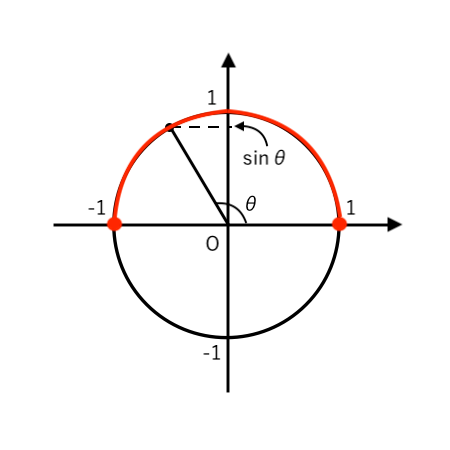
なので、$\sin \theta ≧ 0$($0$以上)とわかります。
(注2)$\sin \theta \cos \theta <0$(かけてマイナス)ということは
$\sin \theta$、$\cos \theta$ のうち一方は「+」、もう一方は「−」(異符号)になります。
上記の(注1)より $\sin \theta ≧ 0$($\color{red}{0}$以上)なので、もう一方の $\cos \theta$ は「−」と分かります。
(注3)$\sin \theta − \cos \theta$ は、
「$\sin \theta ≧ 0$($\color{red}{0}$以上)」と「$− \cos \theta >0$(+)」を足した数なので
$\sin \theta − \cos \theta>0$(+)になります。
別解として、$ \color{red} {\cos \theta} $ を消去して「$ \sin \theta $ の2次方程式」を解くやり方もあります。
- 【別解】を見る
-
【別解】
$ \sin \theta + \cos \theta = \displaystyle {2 \over 3} $ より
$ $ $ \color{red} {\cos \theta} = \displaystyle {2 \over 3} − \sin \theta $
これを
$ $ $ \sin^2 \theta + \color{red} {\cos}^2 \color{red} {\theta} = 1$
に代入して
$ $ $ \displaystyle { \sin^2 \theta + \left( \color{red} { {2 \over 3} − \sin \theta } \right)^2 } = 1$
$ $ ∴ $ \displaystyle { \sin^2 \theta + \left( {4 \over 9} −{4 \over 3}\sin \theta + \sin^2 \theta \right) } = 1$
$ $ ∴ $ \displaystyle { 2 \sin^2 \theta −{4 \over 3}\sin \theta + {4 \over 9} } = 1$
両辺に $9$ をかけて
$ $ $ \displaystyle { 18 \sin^2 \theta −12 \sin \theta + 4 } = 9 $
$ $ ∴ $ \displaystyle { 18 \sin^2 \theta −12 \sin \theta −5 = 0 }$
これを $\sin \theta$ についての2次方程式と見て、解を求めると
$ $ $ \displaystyle { \sin \theta = { 6 \pm \sqrt{ 36 −18 \cdot (−5) } \over 18 } }$ ・・・(注1)
$ $ $ \displaystyle { = { 6 \pm \sqrt{ 126 } \over 18 } }$
$ $ $ \displaystyle { = { 6 \pm 3 \sqrt{ 14 } \over 18 } }$
$ $ $ \displaystyle { = { 2 \pm \sqrt{ 14 } \over 6 } }$
ここで、$0^\circ ≦\theta≦180^\circ$ より $ 0 ≦\sin \theta≦1 $
$ $ ∴ $ \displaystyle { \color{green} {\sin \theta} = { 2 + \sqrt{ 14 } \over 6 } }$ ・・・(注2)
よって
$ $ $ \cos \theta = \displaystyle {2 \over 3} − \color{green} {\sin \theta} $
$ $ $ = \displaystyle {2 \over 3} − \color{green} { 2 + \sqrt{ 14 } \over 6 } $
$ $ $ = \displaystyle { 2 − \sqrt{ 14 } \over 6 } $
ゆえに
$ $ $\sin \theta −\cos \theta$
$ $ $ \displaystyle { = { 2 + \sqrt{ 14 } \over 6 } − { 2 − \sqrt{ 14 } \over 6 } } $
$ $ $ \displaystyle { = { \sqrt{ 14 } \over 3 } } $
(注1)$ \displaystyle { 18x^2 −12x −5 = 0 }$ の解き方について
ふつうの解の公式を使ってしまうと
$ $ $ \displaystyle { x = { 12 \pm \sqrt{ 12^2 −4 \cdot 18 \cdot (−5) } \over 2 \cdot 18 } }$
となって計算が大変ですね。
そこで
$x$ の2次方程式 $ax^2 + bx + c = 0$
において $b$ が偶数のとき、$b = 2b’$ とすると
$ \displaystyle { x = { −b’ \pm \sqrt{ b’^2 − ac } \over a } }$
これを利用すると
$ $ $ \displaystyle { x = { 6 \pm \sqrt{ 6^2 − 18 \cdot (−5) } \over 18 } }$
と、ちょっとだけ楽ができます。
(注2)ここで
「$\displaystyle { \sin \theta = { 2 + \sqrt{ 14 } \over 6 } } $ は、$ 0 ≦\sin \theta≦1 $ の範囲にホントに入ってるの?$\sqrt{ 14 }$ の値なんて覚えてないよ〜」
と思ったキミへ・・・
もし $\sqrt{ 14 }$ の値を知らなくても
$ $ $3^2 < 14< 4^2$ より $3 <\sqrt{ 14 }< 4$
というのは分かりますよね?
ここから $\displaystyle { 2 + \sqrt{ 14 } \over 6 }$ の形に少しずつ近づけていきます。
$ $ $3 <\sqrt{ 14 }< 4$
辺々に $2$ を足して
$ $ $5 <2 + \sqrt{ 14 }< 6$
辺々を $6$ で割って
$ $ $\displaystyle { {5 \over 6}< { 2 + \sqrt{ 14 } \over 6 }<{6 \over 6} }$
$ $ ∴ $\displaystyle { {5 \over 6}<\sin \theta<1 }$
となり、$ 0 ≦\sin \theta≦1 $ を満たしていることが分かりました。
この変形のしかたは、これ以外にも 2次関数など色んな場面で必要となります。
バッチリ覚えておきましょう!
(4) $\sin \theta $
「$\sin \theta$ と $\cos \theta$ の和・差」が分かっているので、そこから $\sin \theta$ の値を求められます。
- 【解答・解説】を見る
-
【解答】
$ \begin{cases}
① \sin \theta + \cos \theta = \displaystyle { 2 \over 3 } \\
\\
③ \sin \theta − \cos \theta = \displaystyle { \sqrt{ 14 } \over 3 } \\
\end{cases}$の辺々を足して
$ $ $ \displaystyle { ( \sin \theta + \require{cancel} \bcancel{ \cos \theta } ) + ( \sin \theta − \bcancel{ \cos \theta } ) = { 2 \over 3 } + { \sqrt{ 14 } \over 3 } } $
$ $ ∴ $ \displaystyle { 2 \sin \theta = { 2 + \sqrt{ 14 } \over 3 } } $
$ $ ∴ $ \displaystyle { \sin \theta = { 1 \over 2 } \cdot { 2 + \sqrt{ 14 } \over 3 } } $
$ $ $ \displaystyle { = { 2 + \sqrt{ 14 } \over 6 } } $
(5) $\displaystyle { \tan \theta − { 1 \over \tan \theta } }$
$\tan \theta $ を消去 → 分数を通分 → 因数分解 すると、対称式が代入できそうな形になります。
- 【解答・解説】を見る
-
【解答】
$\displaystyle { \tan \theta − { 1 \over \tan \theta } }$
$\displaystyle { = { \sin \theta \over \cos \theta } − { \cos \theta \over \sin \theta } }$ $\displaystyle { \left( \tan \theta = {\sin \theta \over \cos \theta} を代入 \right) }$
$\displaystyle { = { \sin^2 \theta − \cos^2 \theta \over \sin \theta \cos \theta } }$ ・・・(注1)
$\displaystyle { = { ( \color{red} { \sin \theta + \cos \theta } ) ( \color{blue} { \sin \theta − \cos \theta } ) \over \color{green} { \sin \theta \cos \theta } } }$
ここに
$ \begin{cases}
① \color{red} { \sin \theta + \cos \theta } = \displaystyle { 2 \over 3 } \\
\\
② \color{green} { \sin \theta \cos \theta } = − \displaystyle { 5 \over 18 } \\
\\
③ \color{blue} { \sin \theta − \cos \theta } = \displaystyle { \sqrt{ 14 } \over 3 } \\
\end{cases}$を代入して
(与式)$\displaystyle { = { \displaystyle { \color{red} { 2 \over 3 } \cdot \color{blue} { \sqrt{14} \over 3 } } \over \displaystyle { \color{green} {−{ 5 \over 18 } } } } } $
$ $ $\displaystyle { = { \enspace \displaystyle { 2 \sqrt{14} \over 9 } \enspace \over \displaystyle {−{ 5 \over 18 } } } } $
$ $ $\displaystyle { = { \displaystyle { { 2 \sqrt{14} \over 9 }× 18 } \over \displaystyle {−{ 5 \over 18 }× 18 } } } $ ・・・(注2)
$ $ $\displaystyle { = − { 4 \sqrt{14} \over 5 } } $
(注1)ここの通分の流れは、例えば
$ $ $\displaystyle { { 4 \over 5 } − { 5 \over 4 } } $
$ $ $\displaystyle { = { 4^2 \over 5 \cdot 4 } − { 5^2 \over 4 \cdot 5 } } $
$ $ $\displaystyle { = { 4^2 − 5^2 \over 5 \cdot 4 } } $
と同様に考えると
$ $ $\displaystyle { { \sin \theta \over \cos \theta } − { \cos \theta \over \sin \theta } }$
$ $ $\displaystyle { = { \sin^2 \theta \over \cos \theta \sin \theta } − { \cos^2 \theta \over \sin \theta \cos \theta } }$
$ $ $\displaystyle { = { \sin^2 \theta − \cos^2 \theta \over \sin \theta \cos \theta } }$
(注2)分数の中に分数が入っているときは、「分母 $\left( \displaystyle {−{ 5 \over 18 } } \right)$ と分子 $\left( \displaystyle { 2 \sqrt{14} \over 9 } \right)$ に同じ数 $\left( 18 \right)$ をかける」と考えるといいです。
あるいは、「割り算(分子 ÷ 分母)」とみなして
$ $ $\displaystyle { { \enspace \displaystyle { 2 \sqrt{14} \over 9 } \enspace \over \displaystyle {−{ 5 \over 18 } } } } $
$ $ $\displaystyle { = { 2 \sqrt{14} \over 9 } ÷ \left(−{ 5 \over 18 } \right) } $
$ $ $\displaystyle { = { 2 \sqrt{14} \over 9 } × \left(−{ 18 \over 5 } \right) } $
と計算してもOK。
Study more!三角比の対称式(交代式)
「三角比の対称式」の問題をもっと解きたい!という人はこちらもどうぞ。
三角比の対称式(交代式)で、テストや大学入試によく出るパターンの問題を網羅したい! 三角比の対称式を、基礎からはじめて 入試の基本レベルまで徐々に学んでいきたい! こういった要望をお持ちの人に向けて、この記事を書きました。 &[…]
【三角比の相互関係】テストによくでる応用問題 Lv.4 (三角方程式)
大きさが未知の角 $\theta$ の三角比を含む方程式を「三角方程式」と言います。
三角方程式も「三角比の相互関係」を使って解くことが多いです。
【問題4】次の等式を満たす $\theta$ を求めよ。ただし、$0^\circ ≦\theta≦180^\circ$ とする。
(1) $ 2 \cos^2 \theta + 3 \sin \theta − 3 = 0 $ [類 滋賀大]
(2) $ \displaystyle { \left| \cos \theta − { 1 \over 2 } \right| = { 1 \over 2 } } $ [15 東北学院大]
(1) $ 2 \cos^2 \theta + 3 \sin \theta − 3 = 0 $
$ \cos \theta$ と $ \sin \theta$ が混ざっていて考えにくいので、まずは片方だけにしたいですね。
「三角比の相互関係」を使うと $ \sin \theta$ だけの式に変形できそうです。
- 【解答・解説】を見る
-
【解答】
$ \sin^2 \theta + \cos^2 \theta = 1 $ より
$ $ $ \color{red} { \cos^2 \theta } = 1 −\sin^2 \theta $
$ 2 \color{red} { \cos^2 \theta } + 3 \sin \theta − 3 = 0 $ に代入して
$ $ $ 2 ( \color{red} { 1 −\sin^2 \theta } ) + 3 \sin \theta − 3 = 0 $
$ $ ∴ $ 2 − 2 \sin^2 \theta + 3 \sin \theta − 3 = 0 $
$ $ ∴ $ − 2 \sin^2 \theta + 3 \sin \theta − 1 = 0 $
両辺の符号を逆にして($−1$をかけて)
$ $ $ 2 \sin^2 \theta − 3 \sin \theta + 1 = 0 $
$ $ ∴ $ ( 2 \sin \theta −1 ) ( \sin \theta −1 ) = 0 $ ・・・(注1)
$ $ ∴ $ \displaystyle { \sin \theta = { 1 \over 2 }, 1 } $
$0^\circ ≦\theta≦180^\circ$ より ・・・(注2)
$ \begin{cases}
\displaystyle { \sin \theta = { 1 \over 2 } } \enspace のとき \enspace \theta = 30^\circ , 150^\circ \\
\\
\displaystyle { \sin \theta = 1 } \enspace のとき \enspace \theta = 90^\circ \\
\end{cases}$よって
$ $ $ \theta = 30^\circ , 90^\circ , 150^\circ $
(注1)ここの因数分解は、2次方程式 $ 2 x^2 − 3 x + 1 = 0 $ で考えると
$ $ $ ( 2 x −1 ) ( x−1 ) = 0 $
$ $ ∴ $ \displaystyle { x = { 1 \over 2 }, 1 } $
これの $x$ を $\sin \theta$ で置き換えればもとの形になります。
(注2)$0^\circ ≦\theta≦180^\circ$ の範囲で
$ $ $ \displaystyle { \sin \theta = { 1 \over 2 }, 1 } $
となるような $\theta$ を考えると
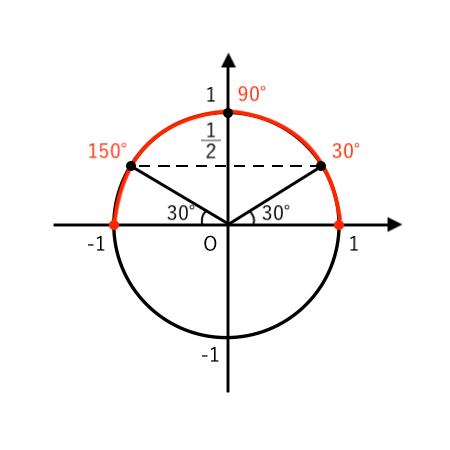
この3つになりますね。
(2) $ \displaystyle { \left| \cos \theta − { 1 \over 2 } \right| = { 1 \over 2 } } $
絶対値の中に三角比が入っている問題です。
「絶対値の外し方」をおさらいしたい人はこちら。
この記事では、絶対値記号のついた等式・不等式の解き方 を解説します。 絶対値の問題は等式・不等式で解き方が変わったり、場合分け が必要になったりするので意外とつまづく生徒が多いです。 |x| = 5 を解くと、どうして x = ± […]
例えば
$ $ $|x| = 2$
の絶対値を外すと
$ $ $x = \pm 2$
の2つ出てきましたね。
- 【解答・解説】を見る
-
【解答】
$ $ $ \displaystyle { \left| \cos \theta − { 1 \over 2 } \right| = { 1 \over 2 } } $
$ $ ∴ $ \displaystyle { \cos \theta − { 1 \over 2 } = \pm { 1 \over 2 } } $
$ $ ∴ $ \displaystyle { \cos \theta = { 1 \over 2 } \pm { 1 \over 2 } } $
$ $ ∴ $ \displaystyle { \cos \theta = 1 , 0 } $
$0^\circ ≦\theta≦180^\circ$ より ・・・(注)
$ \begin{cases}
\cos \theta = 1 \enspace のとき \enspace \theta = 0^\circ \\
\\
\cos \theta = 0 \enspace のとき \enspace \theta = 90^\circ \\
\end{cases}$よって
$ $ $ \theta = 0^\circ , 90^\circ $
(注)$0^\circ ≦\theta≦180^\circ$ の範囲で
$ $ $ \displaystyle { \cos \theta = 1 , 0 } $
となるような $\theta$ を考えると

この2つになります。
別解として「絶対値の形がイヤなので、はじめに 2乗して絶対値を消す やり方」もOK。
- 【別解】を見る
-
【別解】
$ $ $ \displaystyle { \left| \cos \theta − { 1 \over 2 } \right| = { 1 \over 2 } } $
の両辺を2乗して
$ $ $ \displaystyle { \left( \cos \theta − { 1 \over 2 } \right)^2 = \left( { 1 \over 2 } \right)^2 } $
$ $ ∴ $ \displaystyle { \cos^2 \theta −\cos \theta + { 1 \over 4 } = { 1 \over 4 } } $
$ $ ∴ $ \displaystyle { \cos^2 \theta −\cos \theta = 0 } $
$ $ ∴ $ \displaystyle { \cos \theta \enspace ( \cos \theta−1 ) = 0 } $
$ $ ∴ $ \displaystyle { \cos \theta = 0 , 1 } $
$0^\circ ≦\theta≦180^\circ$ より
$ $ $ \theta = 0^\circ , 90^\circ $
どちらのやり方でも出来るようにしておくと、
視野が広がって応用が効くようになる のでオススメです。
ちなみに、もし今回の問題が
$ $ $ \displaystyle { \left| \cos \theta − { 1 \over 2 } \right| = { 1 \over 2 } \cos \theta } $
というような形の場合、
$ $ $ \displaystyle { \cos \theta − { 1 \over 2 } = \pm { 1 \over 2 } \cos \theta } $
とやってしまうと「×」です(もしくは大きく減点されます)。
「え〜なんで〜!?」と思った人は、以下の記事内【パターン3】を読んでおきましょう。
この記事では、絶対値記号のついた等式・不等式の解き方 を解説します。 絶対値の問題は等式・不等式で解き方が変わったり、場合分け が必要になったりするので意外とつまづく生徒が多いです。 |x| = 5 を解くと、どうして x = ± […]
【三角比の相互関係】テストによくでる応用問題 Lv.5 (2次関数)
いよいよ最後の問題です。
三角比と「2次関数」の融合問題は、学校のテスト・大学入試ともに かなり出やすい です。
【問題5】$ 0^\circ≦\theta≦180^\circ $ のとき、$ y = \sin^2 \theta −\cos \theta $ の最大値、最小値を求めよ。
また、そのときの$ \theta $ も求めよ。
[松山大]
三角比 ×2次関数の最大値・最小値
解答の流れ はこんな感じ。
- 「三角比の相互関係」で変形($\cos \theta$ だけで表す)
- $\cos \theta = t$ とおく($t$ の範囲をとる)
- $y$ の式に $\cos \theta = t$ を代入
- $t$ の二次関数とみて 最大・最小を考える
- 最大・最小をとる $\theta$ の値を求める
この流れをイメージしながら解答を書いてみましょう。
- 【解答・解説】を見る
-
【解答】
$\sin^2 \theta + \cos^2 \theta = 1$ より
$ $ $ \color{red} { \sin^2 \theta } = 1 − \cos^2 \theta $
∴ $ y = \color{red} { \sin^2 \theta } −\cos \theta $
$ $ $ = \color{red} { ( 1 − \cos^2 \theta ) } −\cos \theta $
$ $ $ = − \cos^2 \theta −\cos \theta + 1 $
ここで、$\cos \theta = t $ とおくと
$ 0^\circ≦\theta≦180^\circ $ より $ −1≦t≦1 $ ・・・(注1)
よって
$ $ $ y = − t^2 −t + 1 $
$ $ $ = − ( t^2 + t ) + 1$
$ $ $ \displaystyle { = − \left( t + {1 \over 2} \right)^2 −\left( {1 \over 2} \right)^2 \cdot (−1) + 1 }$
$ $ $ \displaystyle { = − \left( t + {1 \over 2} \right)^2 + {5 \over 4} }$
これは
$ \begin{cases}
頂点 \displaystyle { \left( −{1 \over 2} , {5 \over 4} \right) } \\
\\
軸: \displaystyle { t = −{1 \over 2} } \\
\\
上に凸
\end{cases}$の放物線。

$ −1≦t≦1 $ より、$y$ は
$ \begin{cases}
t = −\displaystyle{1 \over 2} \enspace で最大値 \enspace \displaystyle{5 \over 4} \\
\\
t = 1 \enspace で最小値 \enspace−1 \\
\end{cases}$をとる。 ・・・(注2)
・$ t = −\displaystyle{1 \over 2} $ のとき $\cos \theta = −\displaystyle{1 \over 2} $
$ $ $ 0^\circ≦\theta≦180^\circ $ より $ \theta = 120^\circ $ ・・・(注3)
・$ t = 1 $ のとき $\cos \theta = 1 $
$ $ $ 0^\circ≦\theta≦180^\circ $ より $ \theta = 0^\circ $ ・・・(注4)
以上より
$ \begin{cases}
\theta = 120^\circ \enspace で最大値 \enspace \displaystyle{5 \over 4} \\
\\
\theta = 0^\circ \enspace で最小値 \enspace−1 \\
\end{cases}$(注1)$ 0^\circ≦\theta≦180^\circ $ より、$\cos \theta$ のとる範囲を 単位円で確認すると
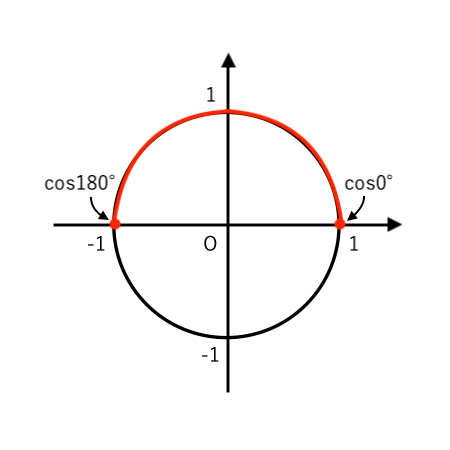
なので、$ −1≦\cos \theta≦1 $ と分かります。
(注2)
【2次関数のグラフ:最大値・最小値の求め方(上に凸の場合)】
① 上に凸 の放物線を(薄めに)かく

② その上に横軸($t$ 軸)をかく

③ 「$t$の範囲の端っこ」「放物線の軸」の値 をとる
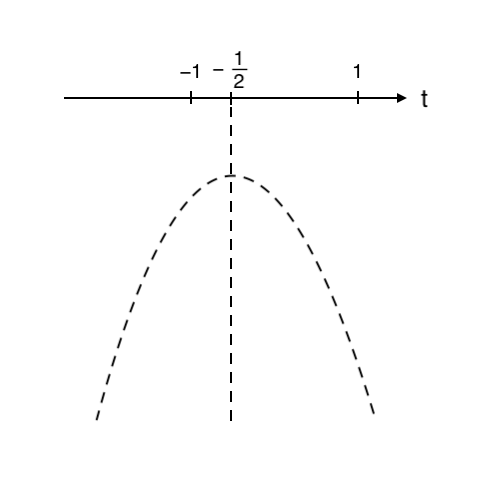
④ 放物線にプロットする

⑤ 範囲の部分を濃く塗る

⑥ 高さが 最大・最小 の点を読み取る

(注3)$ 0^\circ≦\theta≦180^\circ $ の範囲で
$ $ $ \cos \theta = −\displaystyle{1 \over 2} $
となるような $ \theta $ を考えると $ \theta = 120^\circ $

(注4)$ 0^\circ≦\theta≦180^\circ $ の範囲で
$ $ $ \cos \theta = 1 $
となるような $ \theta $ を考えると $ \theta = 0^\circ $

Study more!2次関数の最大値・最小値
「2次関数の最大値・最小値の簡単な求め方(手抜きグラフ速答法)」はこちら。
2次関数の「最大値と最小値を求める問題」がよくわからない・・・ グラフを使ってどうやって求めればいいの? 2次関数の最大値と最小値の簡単な求め方を教えてほしい! こういった要望に応えます。 2次関数の[…]
最後に
- $\sin^2 \theta + \cos^2 \theta = 1$
- $\displaystyle { \tan \theta = {\sin \theta \over \cos \theta} }$
- $\displaystyle { 1 + \tan^2 \theta = {1 \over \cos^2 \theta} } $
今回は「三角比の相互関係」の公式を使って解く応用問題を解説しました。
これらのパターンの問題は、学校のテスト でも 大学入試 でもよく出題されるので、何度も復習してスラスラ解けるようにしておきましょう!
質問・要望があれば気軽にコメントください👍

